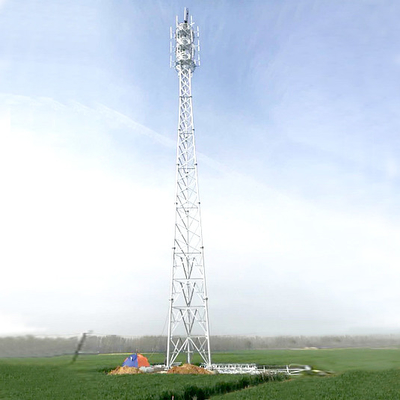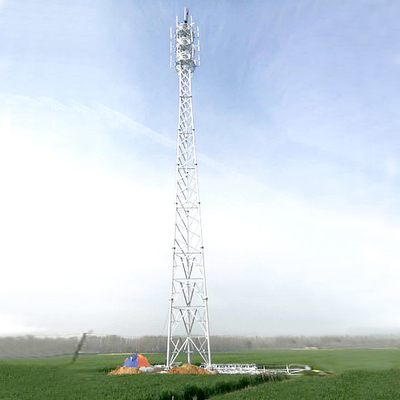-
Telecom Steel Tower
-
Transmission Steel Tower
-
Camouflaged Cell Towers
-
Galvanised Street Light Pole
-
Lattice Steel Towers
-
Solar Panel Support Structure
-
Galvanized Steel Structures
-
Traffic Signal Light Pole
-
Steel Tubular Pole
-
Rooftop Antenna Tower
-
High Mast Light Tower
-
Guyed Wire Towers
-
CCTV Camera Poles
Self Supporting Galvanized Steel Communication Tower S355JR Grade

Contact me for free samples and coupons.
Whatsapp:0086 18588475571
Wechat: 0086 18588475571
Skype: sales10@aixton.com
If you have any concern, we provide 24-hour online help.
x| Anti-corrosion Performance | Hot Dip Galvanized Finish With Minimum 65 Microns | Design Lifespan | 20-50 Years |
|---|---|---|---|
| Earthquake Resistance | Customized To Request | Height | 20-110m |
| Installation Method | Bolt Connection | Material | Structural Mild Steel |
| Surface Treatment | Hot Dip Galvanized Optionally Plus Painting | Tower Accessories | Anchor Bolts, Lightning Rod, Platform, Ladder, Etc. |
| Tower Connection | Flange Connection Or Plate Connection | Tower Foundation | Concrete Foundation |
| Tower Shape | Triangle Or Square Or Polygon | Tower Structure | Multi-facets Lattice Structure |
| Tower Type | 3 Legs Or 4 Legs Or 6 Legs Or 8 Legs Lattice Tower | Steel Grade | Q235B, Q355B, ASTM A35, A572, S235JR, S355JR |
| Wind Speed Resistance | As Per Design Request | ||
| Highlight | Galvanized Steel Communication Tower,Self Supporting Steel Communication Tower,Steel Communication Tower S355JR Grade |
||
80m or Custom Height Self-supporting Galvanized Steel Telecommunication Tower
Self-supporting Galvanized Steel Communication Tower S355JR Grade
As an important and fundamental information infrastructure,Telecommunication towers are used for communication purposes, mounting antennas on towers to effectively transmit and receive communications signals. We're professional manufacturer of telecom towers from Guangzhou, China, we have been specializing in this field for 14 years since 2009 and have become one of leading suppliers in this field, we can fabricate the steel towers or mono poles according to customer's designs, drawings, specifications and requirements.
The popular communication towers include Self-supporting lattice towers, monopoles and guyed towers and the most commonly used type of towers is self-supporting monopole or lattice towers. All the wireless communication, mobile networking, radio broadcasting and TV antennas are mounted on towers and the telecom signals are tranmitting from there. Different heights are used in different places and purposes to maximize the signal coverage.
![]()
3-legged tubular steel triangle lattice tower
Telecom towers are generally made from high quality structural mild steel with minimum yield strength of 235 MPa, the main structures are generally made by higher grade of steel which is upto to 355 MPa yield strength. The popular grades of steel are ASTM A36 (equivalent to Chinese stanard Q235B or ISO S235JR) and A572 (equivalent to Chinese standard Q355B or S355JR), the surface finish treatment is hot dip galvanization and sometimes plus color coating to make towers more identified.
Category of Communications Towers
1, Self-supporting lattice towers
2, Self-support Monopole towers
3, Guyed towers
Self-supporting galvanized steel lattice towers
![]()
4-legged angular steel square latice tower
The self-supporting lattice tower means free standing multi-legs tower without any support, different from guyed tower. The advantages of self-support lattice towers include using less land, wide range applications (can be built on rooftops, mountains or hills, greenfields, deserts, urban or suburban areas etc) and stable structure. Most of the TV, radio, telecom, Power transmission and wind turbine towers are self-supporting towers. The most popular types of self-support steel lattice towers are 3-legged tower and 4-legged tower, sometimes it can also made in 6 or 8 legs structure.
Monopole towers
It is self-supporting single pole, generally built on plains, when number of antennae is not required for many or height of tower is not more than 40m. It is made from steel plate by swaged and welded process, it is generally polygonal tube, for example 8-sided, 12-sided or 18-sided. The advantages of monopole towers include easier installation, occupying less land, suitable to be erected in urban areas.
Guyed towers
Guyed towers are used sometimes because of lower cost of materials, when the budegt for tower is lower while land is enough, it is a good option to use guyed tower instead of self-support tower. It is a lightweight tower in triangle or square section. Guyed towers are generally welded and assembled in factory and divided into some assembled sections, and the main structures are made from steel pipes and tower sections are connected by bolts via flanges when installation.
Other Types of Telecom Towers
Besides above common types of steel towers, artificial bionic tree camouflaged monopole tower, camouflaged antenna tower with fiberglass shroud or cover on top for hiding antennas combined with street lights are also applied in the urban areas as they are working as not only for supporting telecom antennas but also for landscaping.
Specifications of Telecommunications Towers
| Galvanized Steel Communications or Wind Turbine or Power Transmission Tower | ||
| 1. Material | ||
| Weldable Structural Low Carbon Steel Plates or Tubes | ||
| 2. Grade | Main structure | Braces |
| GB/T1591:Q345B | GB/T 700:Q235B | |
| ASTM A572 Gr50 | ASTM A36 | |
| EN10025: S355JR, S355J0,S355J2 | EN10025: S235JR, S235J0,S235J2 | |
| 3. Design Wind Speed | Up to 250 km/h | |
| 4. Allowable deflection | 0.5 ~1.0 degree @ operational speed | |
| 5. Tension strength | 470~630 MPa | 360~510 MPa |
| 6. Yield strength | 355 MPa | 235 MPa |
| 7. Elongation (%) | 24 | 20 |
| 8. Impact strength KV (J) | 27(20°C)---Q345B(S355JR) | 27(20°C)---Q235B(S235JR) |
| Bolts & Nuts | ||
| 9. Grade | Grade 4.8, 6.8, 8.8 | |
| 10. Standards for mechanical properties | ||
| 10.1 Bolts | ISO 898-1 | |
| 10.2 Nuts | ISO 898-2 | |
| 10.3 Washers | ISO 6507-1 | |
| 11. Standards for Dimensions | ||
| 11.1 Bolts | DIN7990, DIN931, DIN933 | |
| 11.2 Nuts | ISO4032, ISO4034 | |
| 11.3 Washers | DIN7989, DIN127B, ISO7091 | |
| Welding | ||
| 12. Method | CO2 Shielded Arc Welding & Submerged Arc Welding(SAW) | |
| 13. Standard | AWS D1.1 | |
| Galvanizing | ||
| 14. Galvanization standard of steel sections | ISO 1461 or ASTM A123 | |
| 15. Galvanization standard of bolts and nuts | ISO 1461 or ASTM A153 | |
General Procedures of Erecting Telecommunications Towers
1, Site geologival investigation or survey to clasify terrain category and confirm it meets tower erection requirements
2, Design tower body and foundations
3, Test and specify the tower body and foundation by professional design and calculation software
4, Specify the tower and foundation dimensions and specifications of materials.
5, Prepare lofting and shop drawing of tower sections
6, Manufacture tower members according to the drawings and specifications.
7, Dig holes for the tower foundations and make a cement underlayer on the bottom
8, Make steel cage frames and anchorages for foundations
9, Make wooden molds for constructing concrete foundations
10, Set up grounding net with steel plates or rods around foundations.
11, Pour concrete and construct bottom blocks and pedestals
12, Dry and watering concrete foundations
13, Test the impact strength and make sure it meets the design specifications.
14, Fix tower footings to foundation pedestals and other tower members
15, Assemble tower sections and antenna brackets, ladder, rest and work platforms, lightning rod, grounding plates etc.
16, Set grouding of tower body and foundations, make sure at least 2 feet of tower must be connected with the ground net, lightning rod must be connected with grounding net through at least 2 foundations.
17, Test the straightness or verticality of tower
18, Complete if all specifications are confirmed.




